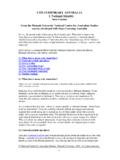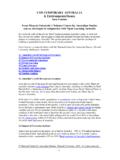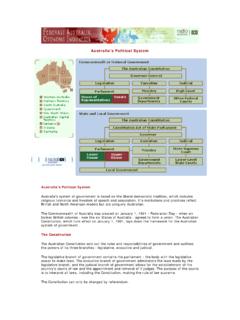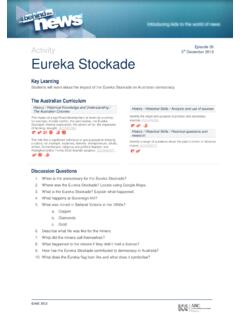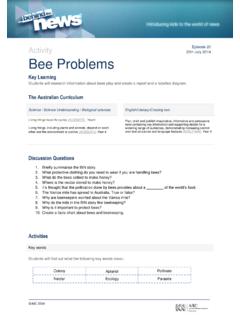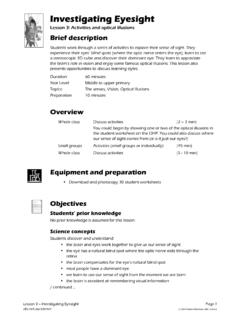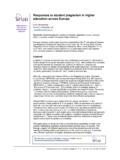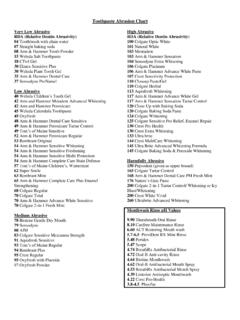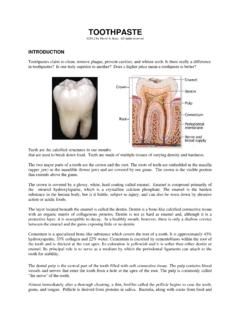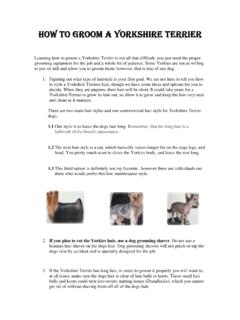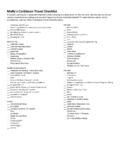Transcription of Teacher Demonstration 26 Elephant’s Toothpaste
1 Teacher Demo 26 elephant s Toothpaste | Page 1 2009 Ruben Meerman | ABC Science Online Teacher Demonstration 26 elephant s Toothpaste This classic chemistry Demonstration is a huge hit with kids of all ages. The title becomes obvious as the reaction converts 125ml of 6% hydrogen peroxide to several litres of harmless, frothy foam which can be safely washed down the sink. It looks just like a giant tube of Toothpaste being squished. Please be prepared for very excited students who will want to see the Demonstration more than once! Materials: 125ml 6% Hydrogen Peroxide (also labelled 20 Vol) 1 Sachet Dry Yeast (powder) + 4 tablespoons of warm water Detergent Food colours optional (not cochineal) Empty bottle Funnel Plastic tray or tub Dishwashing gloves Safety goggles * 6% Hydrogen peroxide (20 Vol) is available in 400ml bottles from most retail chemists and cosmetics suppliers and some supermarkets.
2 Instructions 1 Gather all the materials and set them up on a desk with the students gathered around. 2 Empty a full sachet of dry yeast into a cup. 3. Add four table spoons of warm water and stir until well mixed. Teacher Demo 26 elephant s Toothpaste | Page 2 2009 Ruben Meerman | ABC Science Online 4. The foam produced is safe to touch and can be poured down the sink but you (and student helpers) should wear dishwashing gloves and safety goggles as a precaution and as standard practice when handling chemicals. Use a funnel to pour 125 ml (roughly half a cup) of 6% hydrogen peroxide into the empty soft drink bottle. 5. Add a large squirt of dishwashing liquid.
3 Swirl the bottle to mix the detergent into the hydrogen peroxide. 6. Optional add ten or fifteen drops of food colouring Swirl the bottle to mix the food colouring into the solution. If you are planning to repeat the Demonstration , add food colouring the second time. Note: don t use cochineal as it won t colour the foam effectively 7. All the ingredients are now ready. Use the funnel to pour all of the yeast solution into the bottle. 8. The solution will begin to rapidly produce foam with a much greater volume than the original ingredients. The tiny bubbles are filled with oxygen gas (not air see Teacher notes). 9. As the foam expands, the bottle quickly fills to the brim.
4 When the bottle is full, the excess foam begins to pour out of the bottle. The result resembles a tube of Toothpaste being squeezed far too much. 10. 125ml of hydrogen peroxide produces approximately two litres of foam. The foam will be warm to touch because the underlying chemical reaction is exothermic (releases heat). Rinse all the materials and the plastic tray after the Demonstration . Teacher Demo 26 elephant s Toothpaste | Page 3 2009 Ruben Meerman | ABC Science Online Teacher notes What is hydrogen peroxide? Hydrogen peroxide (in a much stronger 30% concentration) is a chemical well known to hairdressers as a bleaching agent. It is also used to bleach paper and many other industrial chemical processes.
5 In hair dressing bleach, the liquid is incorporated into a thick gel which clings to hair preventing contact with the scalp. The chemical symbol H2O2 for hydrogen peroxide is very similar to water s H2O. The H2 represents two hydrogen atoms while the O2 represents two oxygen atoms (water molecules contain only one oxygen atom). Hydrogen peroxide molecules are very unstable and naturally decompose into water and oxygen gas. The chemical equation for this decomposition is: 2 H2O2 2 H2O + 02 The equation above represents two hydrogen peroxide molecules decomposing into two water molecules and one oxygen molecule (note that all oxygen gas molecules are comprised of two oxygen atoms ozone, by contrast, is comprised of three oxygen molecules and has the chemical symbol O3).
6 The decomposition of hydrogen peroxide also releases a small amount of heat so the reaction is exothermic. Hydrogen peroxide is stored in opaque plastic or brown glass bottles to minimise exposure to light which accelerates the natural decomposition of hydrogen peroxide. Why does yeast accelerate hydrogen peroxide decomposition? Hydrogen peroxide is a natural by-product of metabolism. All known animals which metabolise oxygen produce a natural enzyme called catalase which catalyses the decomposition of hydrogen peroxide into harmless water and oxygen gas. Catalase is found in every organ in the body and in particularly high concentrations in the liver. Hydrogen peroxide is harmful to living things because it is a strong oxidiser which can cause damage to living cells at the molecular level.
7 Yeast is a fungi which also produces the catalase enzyme. Adding yeast to hydrogen peroxide then, rapidly increases (catalyses) the decomposition of hydrogen peroxide into water, oxygen gas and heat (you will notice that the foam produced feels warm). In potatoes, catalase is present in sufficient quantities to produce visible bubbles of oxygen when a freshly cut piece is coated with 3% hydrogen peroxide. Many other chemicals catalyse the decomposition of hydrogen peroxide into water and oxygen gas. Some catalysts such as potassium iodide are particularly efficient catalysts for the decomposition but almost any super fine powder will cause the decomposition to accelerate.
